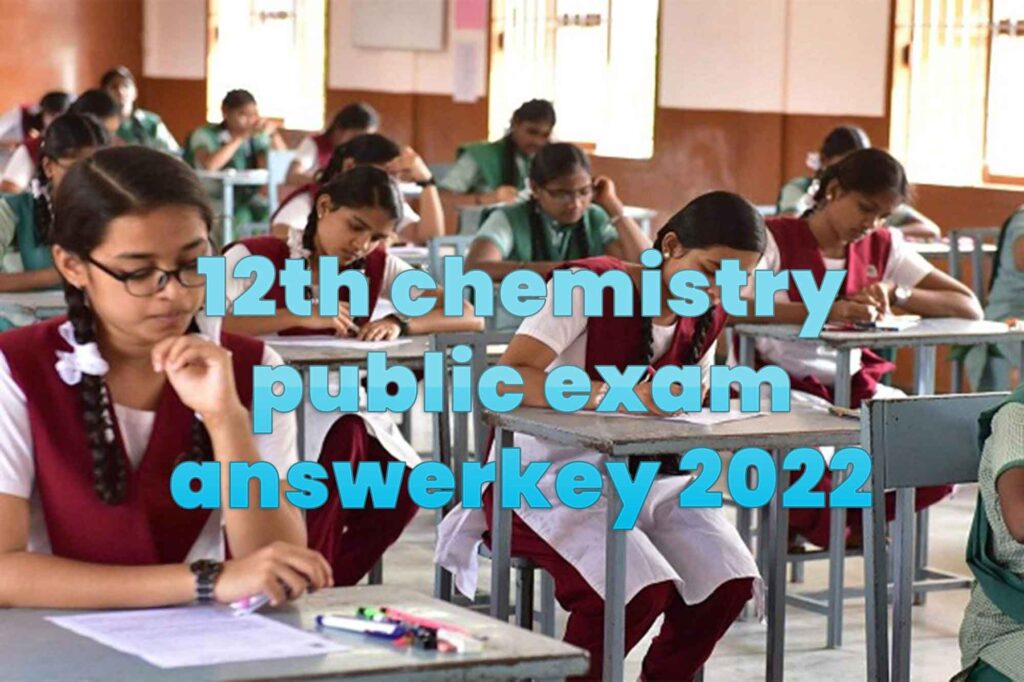12th chemistry public exam answer key 2022 :- 12th chemistry public exam 2022 original question papers answer keys available in this page. We already published Public Exam answer key for 12th standard students,11th standard students and 10th standard students.We already have a teachers team to provide original question papers answer keys today.12th Public Exam Original Question Paper and Answer Key May 2022 available in pdf file.

12th chemistry public exam 2022
To help 12th standard chemistry students Model question paper with answer key in our site.Computer scien public exam 2022 original question papers answer key available to you another day. we already post 12th tamil public exam ,12th english public exam,12th chemistry public answer key prepareations are done mya group of teachers.
1.தனிம வரிசை அட்டவணையில், 15-ம் தொகுதி 3-ம் வரிசையில் உள்ள ஒரு தனிமத்தின் எலக்ட்ரான் அமைப்பு :

Answer:-
1.An element belongs to group-15 and 3rd period of the periodic table. Its electronic configuration would be

Answer:-
2.பாக்ஸைட்டின் இயைபு :
2.Bauxite has the composition :

ஒரு முதல் வகை வினையானது 60 நிமிடங்களில் 75% நிறைவு பெறுகிறது. அதே வினை, அதே நிபந்தனைகளில் 50% நிறைவு பெறத் தேவையான காலம்:
(அ) 35 நிமிடங்கள்
(ஆ) 20 நிமிடங்கள்
(இ) 75 நிமிடங்கள்
(ஈ) 30 நிமிடங்கள்
If 75% of a first order reaction was completed in 60 min, 50% of the same reaction under the same conditions would be completed in:
(a) 35 minutes.
(c)
75 minutes.
(b) 20 minutes
(d) 30 minutes
பின்வருவனவற்றுள் எந்த வினைக் காரணி நைட்ரோ பென்சீனை அனிலீனாக மாற்றுகிறது ?
(அ) ZnHg/NaOH
(ஆ)Zn/NH,CI
(இ) Sn/HC1
(ஈ) இவை அனைத்தும்
Which of the following reagent can be used to convert nitrobenzene to aniline ?
(a) ZnHg/NaOH
(b) Zn/NH4Cl
(c) Sn/HCl
(d) All of these
HO-CH2-CH-OH -ஐ பெர்அயோடிக் அமிலத்துடன் வெப்பப்படுத்தும் போது உருவாவது :
(அ) மெத்தனல்
(ஆ) மெத்தனாயிக் அமிலம்
(இ) CO2
(ஈ) கிளையாக்சால்
HO- CH2- CH2- OH on heating with periodic acid gives :
(a) Methanal
(b) Methanoic acid
(c) CO2
(d) Glyoxal
உலோக அயனியின் ஆக்ஸிஜனேற்ற எண் பூஜ்ய மதிப்பினைப் பெற்றிருக்கும் அணைவுச் சேர்மம் :
(அ) K4[Fe(CN)6]
() [Fe(CO)s]
(ஆ) [Fe(CN)3 (NH3)3]
(ஈ) (ஆ) மற்றும் (இ) இரண்டும்
A complex in which the oxidation number of the metal is zero is :
(a) K4[Fe(CN)6]
(b) [Fe(CN)3(NH3)3]
(c) [Fe(CO)5]
(d) Both (b) and (c)
A
( திருப்புக / Turn over
5922
- பின்வருவனவற்றுள் எது லௌரி-ப்ரான்ஸ்டட் அமிலமாகவும், காரமாகவும் செயல்பட
முடியும்?
(அ) HPO2
(ஆ) HCI
(இ) Br
(FF) SO2
Which of the following can act as Lowry-Bronsted acid as well as base ?
(a) HPO?
(b) HC1
(c) Br
(d) so2
8.
போராக்ஸின் நீர்க் கரைசலானது :
(அ) காரத் தன்மை உடையது
(ஆ) நடுநிலைத் தன்மை உடையது
(இ) ஈரியல்புத் தன்மை உடையது
(ஈ) அமிலத் தன்மை உடையது
An aqueous solution of borax is :
(a) basic
(b) neutral
(c) amphoteric
(d) acidic - பின்வருவனவற்றுள் எது ஒருபடித்தான வினைவேக மாற்றத்திற்கு எடுத்துக்காட்டு ?
(அ) எண்ணெயின் ஹைட்ரஜனேற்றம் (ஆ) ஹேபர் முறையில் அமோனியா தயாரித்தல்
(இ) நீர்த்த HCI முன்னிலையில் சுக்ரோசின் நீராற்பகுத்தல்
(ஈ) தொடு முறையில் கந்தக அமிலம் தயாரித்தல்
Which one of the following is an example for homogeneous catalysis ? (a) Hydrogenation of oil
(b) Manufacture of ammonia Haber’s process
(c) Hydrolysis of sucrose in presence of dil.HCI (d) Manufacture of sulphuric acid by Contact process
A
5
5922
- அசிட்டோனிலிருந்து சயனோஹைட்ரின் உருவாகும் வினை பின்வருவனவற்றுள் எதற்கு சான்றாக உள்ளது ?
(அ) எலக்ட்ரான் கவர் சேர்ப்பு வினை
(ஆ) கருகவர் பதிலீட்டு வினை
(இ) கருகவர் சேர்ப்பு வினை
(ஈ) எலக்ட்ரான் கவர் பதிலீட்டு வினை
The formation of cyanohydrin from acetone is an example of :
(a) electrophilic addition.
(b) nucleophilic substitution
(c) nucleophilic addition
(d) electrophilic substitution
11.பின்வரும் ஆக்சிஜனேற்ற நிலைகளுள், லாந்தனாய்டுகளின் பொதுவான ஆக்சிஜனேற்ற
நிலை யாது ?
(அ) +5
(ஆ) +4
(இ) +3
(ஈ) +2
Which of the following oxidation states is most common among the lanthanoids ?
(a) +5
(b)
+4
(c)
+3
(d)
+2 - ஃபாரடே மாறிலி என வரையறுக்கப்படுகிறது.
(அ) ஒரு மோல் பொருளை விடுவிக்க தேவைப்படும் மின்னூட்டம்
(ஆ) 1 எலக்ட்ரானால் சுமந்து செல்லப்படும் மின்னூட்டம் (இ) 6.22 × 1010 எலக்ட்ரானால் சுமந்து செல்லப்படும் மின்னூட்டம்
(ஈ) 1 மோல் எலக்ட்ரானால் சுமந்து செல்லப்படும் மின்னூட்டம்
Faraday constant is defined as: (a) Charge required to deposit one mole of substance
(b) Charge carried by 1 electron. (c) Charge carried by 6.22 × 1010 electrons
(d) Charge carried by one mole of electrons
A
( திருப்புக / Turn over
5922
- பின்வரும் அமினோ அமிலங்களில் எது சீர்மையுடையது ?
(அ) புரோலின்
(ஆ) அலனின்
(இ) கிளைசீன்
(ஈ) லியுசின்
Which of the following amino acids are achiral?
(a) Proline
(b) Alanine
(c) Glycine
(d) Leucine - உலோக குறையுள்ள குறைபாடு காணப்படும் படிகம் :
(அ) Zno
(ஆ) NaC1
(இ) KC1
(ஈ) FeO
The crystal with a metal deficiency defect is :
(a) ZnO
(b) NaCl
(c) KCI
(d) FeO - மூடுபனி என்பது எவ்வகை கூழ்மம் ?
(அ) வாயுவில் நீர்மம்
(ஆ) வாயுவில் திண்மம்
(இ) நீர்மத்தில் வாயு
(ஈ) வாயுவில் வாயு
Fog is colloidal solution of:
(a) liquid in gas
(b) solid in gas
(c) gas in liquid
(d) gas in gas
A
7
5922
பகுதி – II / PART – II
குறிப்பு : ஏதேனும் ஆறு வினாக்களுக்கு விடையளிக்கவும். வினா எண் 24-க்கு கட்டாயமாக விடையளிக்கவும்.
Note :
Answer any six questions. Question No. 24 is compulsory.
6×2=12
- கனிமம் மற்றும் தாது ஆகியவற்றிற்கிடையேயான வேறுபாடுகள் யாவை ? What are the differences between minerals and ores ?
- Fe3+ மற்றும் Fe2+ -ல் எது அதிக நிலைப்புத் தன்மை உடையது ? ஏன் ? Which is more stable Fe3+ or Fe2 + ? Why ?
- அணைவு எண் – வரையறுக்கவும். Define Coordination number.
- சகப்பிணைப்புப் படிகங்கள் – வரையறுக்கவும்.
Define covalent solids. - முதல் வகை வினைக்கான எடுத்துக்காட்டுகளை எழுதுக. Give examples for the first order reaction.
- அரீனியஸ் கொள்கையின் வரம்புகள் யாவை ?
What are the limitations of Arrhenius concept? - மின்முனைக் கவர்ச்சி – குறிப்பு வரைக. Write a note on Electrophoresis.
A
( திருப்புக / Turn over
5922
8
- IUPAC பெயரினைக் குறிப்பிடுக.
CH2-OH
CH3 | (அ) CH3-C – OH CH3 Give the IUPAC names:
(ஆ)
CH3
| CH3-C – OH
(b)
CH2-OH
CH3 - பின்வரும் வினைவரிசையில் உள்ள A மற்றும் B சேர்மங்களை கண்டறிக.
CH3 – Br NaN3 → A LiAlH4_→ B + N2
Identify A and B in the following sequence of reactions.
CH3 – Br NaN3 A LAIH4 → B + N2
பகுதி – II / PART – III
குறிப்பு : ஏதேனும் ஆறு வினாக்களுக்கு விடையளிக்கவும். வினா எண் 33-க்கு கட்டாயமாக விடையளிக்கவும்.
6×3=1
Note :
Answer any six questions. Question No. 33 is compulsory. - ஹாலஜனிடைச் சேர்மங்கள் என்றால் என்ன ? எடுத்துக்காட்டு தருக.
What are interhalogen compounds ? Give examples.
A
5922
9
- இடைச்செருகல் சேர்மங்களின் பண்புகள் யாவை ?
What are the properties of interstitial compounds ? - அர்ஹீனியஸ் சமன்பாட்டினை எழுதி அதில் இடம் பெற்றுள்ளவற்றை விளக்குக. Write Arrhenius equation and explain the terms involved.
- மின்பகுளிக் கடத்துத்திறனை பாதிக்கும் காரணிகள் யாவை ? What are the factors that affects electrolytic conductance ?
- ஒருபடித்தான வினைவேக மாற்றம் என்றால் என்ன ? எடுத்துக்காட்டு தருக. What is homogeneous catalysis? Give example.
- டை எத்தில் ஈதர் தயாரிக்கும் ஏதேனும் ஒரு முறையை எழுதுக. Write any one method of preparation for diethyl ether.
- ஹேலோஃபார்ம் வினையை எழுதுக. Write Haloform reaction.
- எபிமர்கள் என்றால் என்ன ? எடுத்துக்காட்டு தருக.
What are Epimers ? Give example. - [Ag(NH3)2|+ -ன் ஈனி, மைய உலோக அயனி மற்றும் IUPAC பெயரை எழுதுக. Write the following for the complex [Ag(NH3)2]*. (a) Ligand (b) Central metal ion (c) IUPAC name
A
( திருப்புக / Turn over
5922
10
பகுதி – IV / PART – IV
5×5=25
குறிப்பு : அனைத்து வினாக்களுக்கும் விடையளிக்கவும்.
Note :
Answer all the questions.
- (அ) (i) புவி ஈர்ப்பு முறை – குறிப்பு வரைக.
(ii) நிக்கலைத் தூய்மையாக்கப் பயன்படும் மாண்ட் முறையினை விளக்குக.
அல்லது
() (i)
மந்த இணை விளைவு என்றால் என்ன?
(ii) போரிக் அமிலத்தின் பயன்கள் யாவை ?
(a) (i)
Write a note on gravity separation method. (ii) Explain the Mond’s Process of refining nickel.
OR
(b)
(i) (ii) What is inert pair effect? What are the uses of boric acid ? - (அ) (i)
ஆக்ஸிஜனின் பயன்கள் யாவை ?
(ii) சலவைத்தூள் எவ்வாறு தயாரிக்கப்படுகிறது ?
அல்லது
(ஆ) வெர்னர் கொள்கையின் கோட்பாடுகளைக் கூறுக. What are the uses of oxygen ?
(a) (i)
(ii) How will you prepare bleaching powder ?
(b)
Write the postulates of Werner’s Theory..
OR
A
11
- (அ) படிக திண்மங்களை படிக வடிவமற்ற திண்மங்களிலிருந்து வேறுபடுத்துக.
5922
அல்லது
() (i) pH – வரையறுக்கவும்.
(ii) பொது அயனி விளைவை ஒரு எடுத்துக்காட்டுடன் விளக்குக. (a) Differentiate crystalline solids and amorphous solids.
(b)
OR
(i) Define pH.
(ii) Explain common ion effect with example. - (அ) நெர்ன்ஸ்ட் சமன்பாட்டைத் தருவிக்கவும்.
அல்லது
(ஆ) வினைவேக மாற்றியின் சிறப்பியல்புகள் யாவை ?
(a) Derive an expression for Nernst equation.
OR
What are the characteristics of catalyst?
(b) - (அ) ஃபார்மிக் அமிலத்தின் ஒடுக்கும் பண்பினை எடுத்துக்காட்டுடன் விளக்குக.
அல்லது
(ஆ) சிறுகுறிப்பு வரைக.
(i) கார்பைலமீன் வினை
(ii) காப்ரியல் தாலிமைடு தொகுப்பு
(a) Explain the reducing action of formic acid with example.
OR
(b) Write a note on :
(i) Carbylamine
reaction (ii) Gabriel phthalimide synthesis
A
